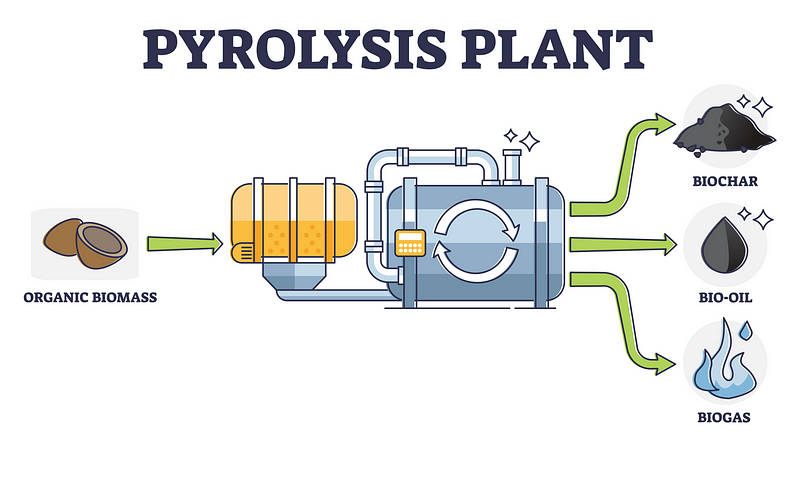Harnessing Coconut Waste to Combat Climate Change: A Biofuel Solution
Written on
The Climate Crisis and Fossil Fuels
The primary driver behind the ongoing climate crisis is the excessive carbon dioxide (CO2) emissions generated by human activities. CO2, a greenhouse gas, is released into the atmosphere through the combustion of fossil fuels such as diesel and gasoline. This gas traps heat radiated from the Earth's surface, preventing it from escaping into space, which leads to global warming and a plethora of environmental consequences.
In addition to CO2 emissions, the burning of fossil fuels poses other significant problems. For one, it contributes to air pollution, adversely affecting public health. Furthermore, fossil fuels are finite resources that take millions of years to form, meaning they will eventually be depleted.
Given these challenges, the search for renewable energy alternatives has intensified. For instance, in previous discussions, I explored how microalgae can serve as a viable biofuel alternative and the potential of lab-grown plant materials for biofuel production.
Coconut Waste: An Abundant Resource
Coconut waste (Cocos nucifera) stands out as a readily available biomass, generating approximately 62.5 million tons annually across over 90 countries. To put this into perspective, that amount is roughly equivalent to 10.9 Great Pyramids of Giza!
This waste can be transformed into biochar, bio-oil, and biogas—solid, liquid, and gaseous fuels, respectively. Biochar, often referred to as charcoal, is rich in essential nutrients, making it not only a solid fuel but also a beneficial fertilizer. Moreover, it has the capacity to sequester CO2, thereby aiding in climate change mitigation. Other uses include enhancing water treatment processes and composting.
Bio-oil, or bio-crude, comprises around 200 different molecules, with 15-35% of its weight being water. This renewable fuel closely resembles diesel and can be utilized in diesel engines. Biogas, a mixture of gases such as methane (CH4), hydrogen (H2), carbon monoxide (CO), and CO2, can generate electricity or serve as an alternative to natural gas.
The Production Process: Pretreatment and Pyrolysis
The journey from coconut waste to fuel involves two key stages: pretreatment and pyrolysis.

Pretreatment
The initial phase of fuel production entails pretreatment, which consists of three steps:
- Washing: Coconut waste is washed with distilled water to eliminate impurities that could damage processing equipment.
- Drying: The waste is then dried—either in the sun or an oven—to achieve a moisture content of 10–12%, enhancing the efficiency of the pyrolysis process.
- Grinding: Lastly, the dried waste is milled and sifted to obtain the appropriate particle size, critical for optimal heating rates during pyrolysis.
Pyrolysis
The second phase, pyrolysis, involves decomposing biomass at elevated temperatures without oxygen. Various factors influence the output of biochar, bio-oil, and biogas. This process is elaborated upon in the following video:
Among the factors affecting pyrolysis are the type of biomass, temperature, and heating rate. Coconut waste is particularly suited for this process due to its high lignin content, which contributes to its structural integrity.
Temperature variations also significantly impact the output; for instance, increasing the temperature from 350 °C (662 °F) to 600 °C (1,112 °F) can decrease biochar yield by about 10%. A higher heating rate allows for faster conversion of coconut waste into biofuels, leading to three distinct pyrolysis types:
- Slow Pyrolysis: Operates at 350 °C to 600 °C with a slow heating rate of 5 °C per minute, yielding primarily biochar.
- Fast Pyrolysis: Requires finely ground coconut waste to achieve a heating rate of 10 °C per minute at a controlled temperature of around 500 °C, producing mainly bio-oil.
- Flash Pyrolysis: Uses extremely fine particles (about 200 µm) with rapid heating rates of 1,000 to 10,000 °C per second, primarily generating biogas along with substantial bio-oil.
Taking Action: Utilizing Coconut Waste
The utilization of coconut waste through pyrolysis offers a renewable alternative to fossil fuels. Depending on the desired output, different pyrolysis methods can be employed to produce biochar, bio-oil, or biogas. These products are not only more sustainable but also serve as effective replacements for traditional fossil fuels, such as diesel.
Here are some practical ways you can incorporate coconut waste into your daily life:
- Chop coconut husks into small pieces to enrich your compost pile.
- Use coconut shells as bird feeders.

- Cut coconut husks into larger pieces for mulch in garden beds.
- Mix coconut coir fibers with soil to enhance moisture retention, particularly useful during droughts.
- Craft products like candle holders and decorative bowls from coconut shells.
- Opt for coconut waste-based products, such as mats and ropes, over plastic alternatives.
Which of these suggestions can you implement in your life? Do you have any other ideas for utilizing coconut waste? Your thoughts and suggestions can inspire others!
If you found this article informative, you might also enjoy my book "A Guide to A Healthier Planet," which delves deeper into environmental issues and solutions.
A Guide to a Healthier Planet
This book aims to bridge the gap between scientific knowledge and actionable insights on pressing environmental challenges.
About the Author
Dr. Erlijn van Genuchten is a globally recognized expert in environmental sustainability. As a science communicator, she aids scientists in conveying their findings to the public and empowers individuals to apply scientific knowledge toward a sustainable future. Through her initiatives, including her YouTube channel "Xplore Nature" and her published works, she has inspired countless individuals worldwide.
Credit
This article is based on:
Azeta, O., Ayeni, A. O., Agboola, O., & Elehinafe, F. B. (2021). A review on the sustainable energy generation from the pyrolysis of coconut biomass. Scientific African, 13, e00909.
The first video title is Briquettes Made From Coconut Waste Could Reduce Deforestation - YouTube. This video discusses how utilizing coconut waste can help diminish deforestation and promote sustainability.
The second video title is How Biodegradable Coolers Are Made Out Of Coconut Waste | World Wide Waste | Business Insider - YouTube. This video explores innovative products made from coconut waste, showcasing their potential for sustainability.